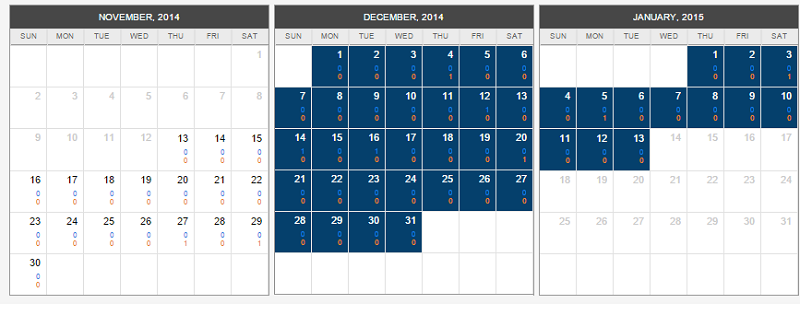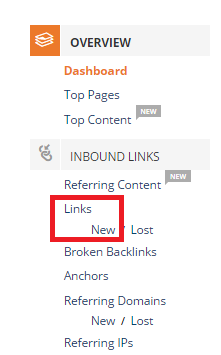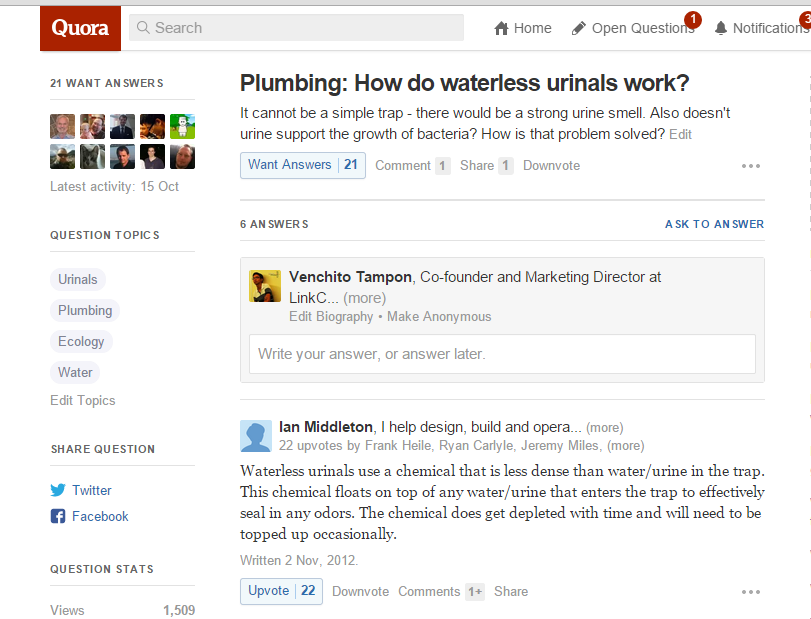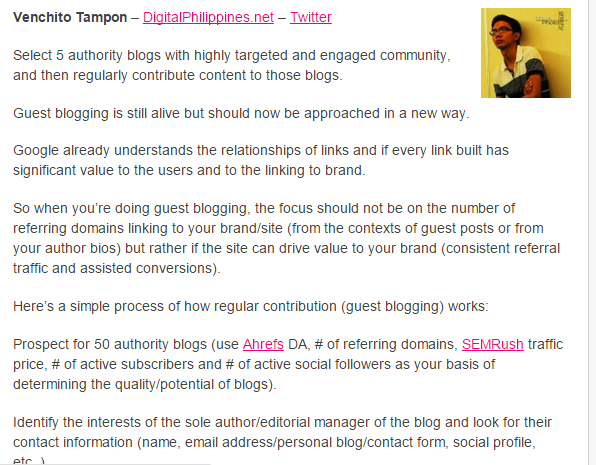by Venchito Tampon Jr | Last Updated on October 24, 2021
From the first release of Penguin filter to its constant updates being made by Google, many link developers had almost transitioned themselves from pursuing unnatural linking practices to executing link building tactics with business goals in mind.
The transition wasn’t easy given that search professionals and agency owners should be aware of the requirements of a solid link building campaign (i.e. content development costs, labor costs, extensive time and effort, etc..) which most of the clients I’ve worked with didn’t want to invest in those project costs.
I believe those brands who want to win over their competitors on the web need to understand the value of link building in the post-penguin era – which is far beyond the common main target – links.
Several reasons why manual/natural link acquisition is the way to go link building approach in this digital age:
- It can help achieve both short term and long term business objectives.
- It improves branding through exemplifying authority and expertise on other websites’ pages and contents (news, articles, press releases, etc..).
- It helps build a natural link profile, which is what Google wants in every website to have and to maintain.
- It builds trust from search engines and users – which is a primary reason why customers and brand evangelists would eventually follow the brand.
- It can positively affect sales and business growth.
Here are a few natural link acquisition tactics that I personally use to achieve overwhelming results for my clients.
Search-dependent link acquisition
Relying on search in order to continuously attract incoming links to a specific page/website is the basic link building principle we all know as search marketers.
The higher the page’s ranking is, the higher are the chances of acquiring new links to the page/site from bloggers and researchers who’d like to reference the content from their own works.
Search-dependent link acquisition could easily be broken down into three steps: identifying keywords to rank for, creating content on a specific topic/keyword and manually reaching out to potential linkers.
Identify keywords to rank for
Keyword research is the most basic skill in search marketing (if you still don’t have any background on it, you can check out this great resource on Backlinko).
When finding topics/keywords to target for a page/content, your top consideration should be its referential ability. Do people searching for the keyword want to reference any page in the search results from their own blogs/sites? If yes, then add that keyword to your list of potential content topics.
This phrase – “how to use pesticides safely” is referential in nature (bloggers/researchers searching for this phrase would likely link to top useful pages in search results). While this term – “what is pesticides” can easily be answered by a short form content. The comprehensiveness wouldn’t be necessary given that searchers can be satisfied quickly with the definition of that term (pesticides).
Keywords with high search volumes are the best phrases to target in content marketing. In many cases, this principle is true, but it doesn’t mean that along tail search query that doesn’t have a significant search volume is not worth considering.
Consider medium-based keyword and long tail phrases when finding the best term/keyword to target for your future content asset.
Identify the linking potential of the keyword by analyzing the top pages in that specific content. Get 3 ranking pages in the search results.
Examine each page and find linking patterns in the last one or two months. Does the page earned links in the last month(s)?
Go deeper by analyzing its’ new links for the past one or two months.
 Do this for all the remaining four ranking pages in the search results.
Do this for all the remaining four ranking pages in the search results.
With that approach, you can estimate the average # of links you can acquire from ranking your page for that specific keyword (though this varies because your future content might rank for other related search terms as well).
See if all domains ranking in the search results are highly authoritative (with high domain authority and trust flow – a metric used by MajesticSEO). If the top 20 domains in the search results have domain authority of 50 and above and you’re a new brand in the industry, consider long tail queries.
Consider the evergreen nature of the keyword. Once you target it, ask yourself, “do you need to constantly update your content to stay ahead of the competition (among all ranking pages)?”. If it only requires semi-annual or annual content update, then the keyword is good to consider as an evergreen topic. One example of an evergreen phrase is how to get out of debt (which will only take you once a year to update your future content if you target that keyphrase).
Determine if there are several linking opportunities from pages ranking for the keyword (see pages that linked to ranking pages). The more resource pages you see from other sites/competitors, the better off you’ll receive visits from them through referral.
Check out commonly asked questions in forums and Q&A sites and see if there’s a great linking potential when you target those questions/phrases using the approach I shared earlier.
Finally, assess your brand’s resources. Are you capable of creating the best content on the specific topic/keyword you’ve chosen? Best content requires expertise to step up in the game and get the top spot in the search results. However, there are cases where you only need a thorough research to provide uniquely useful information in your content – you can outperform ranking pages by focusing on other content elements – visually appealing design, higher number of words, more tips, etc..
Create content
There’s no need to discuss why content is king (check out this resource if you need to).
I’ve written several posts around content creation, but just a recap of what I’ve shared in the past, here are a few tips you can immediately apply to content development.
- Understand the intent of the searcher. Make your best effort to provide the most exact and useful information on the specific keyword/topic you’re trying to rank for.
- Invest in design (“It’s the 50% of the battle”, says Rand Fishkin).
- Remove unnecessary internal and external links within the body of the content to help users focus on consuming the overall texts in the content.
- Use data-based elements (case studies, graphs, brand’s internal research) to support your own opinions/insights.
Practice submitting your content to higher-level managers or clients for content approval in order to get feedback and suggestions from them. This approach will likely improve your strategy when creating content for your future content assets.
Manual outreach
There are many ways to build links to one’s content nowadays, but the following tactics are the most effective ones:
- Resource page link building – reach out to links/resources pages and suggest to replace the broken link(s) in the page with the link pointing to your brand’s content asset.
- Content contribution – pitch industry-related blogs and ask if they’ll be interested to get you as their regular content contributor (links from third-party contents will be pointing to your content asset).
- Linker outreach – manually send emails to potential linkers and simply share the brand’s content (if it is highly useful, then there’s a high possibility to get a link).
Manual outreach requires research, discovery, due diligence and negotiation, which is the main reason why a link is so expensive.
Useful resources on manual outreach:
- Targeting Outreach and Influencers for Social Traction
- How to Create a Winning Content Promotion Plan
Once the content starts to rank highly in search results, it will receive continuous flow of search visits – a big part of them are bloggers and researchers who would likely to link to your brand’s content.
Traffic generators
Building links that drive relevant traffic to the site is one of the effective natural link acquisition approaches given that it assures the relevancy between the brand and the linking site/page (higher visits means the brand is topically relevant to the linking blog/site).
Traffic generator links will also accumulate additional in-content links from another set of bloggers/researchers (those who visit the brand coming from the linking site/page).
Be strategic with what how you place your link within the content’s body of your third-party contents (guest post, news pitch, etc..) since that will determine how relevant and useful your page is (which would help your new visitors from other sites to decide whether to link to your page or not).
Contribute to sites with high search and market share to increase your chances of ranking your external content for long tail niche-specific keywords. The more traffic it receives from search, the likelihood of getting referral traffic from other sites and attracting more natural links to your internal content is higher.
Track unlinked and linked mentions of your brand to identify linking pages where you can pitch and acquired another recurring links almost every month (roundup posts, list posts, bloggers list post, etc..).
Participate in industry-related forums with the intention of driving click through traffic from community sites and bringing new potential linkers to your page/site. That objective could help you increase your natural links from bloggers and webmasters who’re looking for references for their own contents.
We recently launched our new agency – LinkCore Media, a link development and content marketing agency. If you’re looking for a high quality link building service, then you can contact our team to help you create a link strategy that fits your brand and industry.
The Author
Venchito Tampon Jr
Venchito Tampon is a Filipino Motivational Speaker, Corporate Trainer, and a Leadership Speaker in the Philippines. He is the CEO and Co-Founder of SharpRocket, a link building agency. With a decade of experience, Venchito has a proven track record of leading hundreds of successful SEO (link builidng) campaigns across competitive industries like finance, B2B, legal, and SaaS. His expert advice as a link building expert has been featured in renowned publications such as Semrush, Ahrefs, Huffington Post and Forbes. He is also an international SEO spoken and has delivered talks in SEO Zraz, Asia Pacific Affiliate Summit in Singapore, and Search Marketing Summit in Sydney, Australia. Check out his other businesses, Hills & Valleys Cafe, Blend N Sips and Saas Pursuit.
How our LINK BUILDING AGENCY builds 250 links/mo consistently using Predictable Link Building Methodology™…
- Using a SIMPLE and PROVEN system
- Using a SCALABLE strategy
- No private blog networks
- No creepy outreach emails





